Effects of Ramadan Observance on Dietary Intake and Body Composition of Adolescent Athletes: Systematic Review and Meta-Analysis
Abstract
1. Introduction
2. Materials and Methods
2.1. Protocol
2.2. Eligibility Criteria
2.3. Information Sources and Search
2.4. Study Selection
2.5. Data Collection Process
2.6. Quality Assessment
2.7. Meta-Analysis
3. Results
3.1. Study Selection
3.2. Study Characteristics
3.2.1. Effects of Ramadan Fasting on Body Mass
Body Mass Before vs. First Week of Ramadan
Body Mass Before vs. Second Week of Ramadan
Body Mass Before vs. Fourth Week of Ramadan
3.2.2. Effects of Ramadan Fasting on Body Composition
Effects of Ramadan Fasting on Body Fat Mass (kg)
Effects of Ramadan Fasting on Body Fat Percentage (%)
3.2.3. Effects of Ramadan Fasting on Lean Mass (kg)
Lean Mass Before vs. Fourth Week of Ramadan
3.2.4. Effects of Ramadan Fasting on Dietary Intake
Total Energy Intake Before vs. During Ramadan
Protein Intake (g) Before vs. During Ramadan
Fat Intake (g) Before vs. During Ramadan
Carbohydrates Intake (g) Before vs. During Ramadan
Total Water Intake (L) Before vs. During Ramadan
3.3. Quality Assessment
4. Discussion
5. Strengths and Weaknesses
6. Conclusions
Supplementary Materials
Author Contributions
Funding
Conflicts of Interest
References
- Rodriguez, N.R.; DiMarco, N.M.; Langley, S. Position of the American Dietetic Association, Dietitians of Canada, and the American College of Sports Medicine: Nutrition and athletic performance. J. Am. Diet. Assoc. 2009, 109, 509–527. [Google Scholar] [PubMed]
- Ackland, T.R.; Lohman, T.G.; Sundgot-Borgen, J.; Maughan, R.J.; Meyer, N.L.; Stewart, A.D.; Müller, W. Current status of body composition assessment in sport: Review and position statement on behalf of the ad hoc research working group on body composition health and performance, under the auspices of the I.O.C. Medical Commission. Sports Med. 2012, 42, 227–249. [Google Scholar] [CrossRef] [PubMed]
- Stewart, A.; Ackland, T. Anthropometry in physical performance and health. Body Compos. Health Perform. Exerc. Sport 2017, 89–108. [Google Scholar]
- Vardar, S.A.; Tezel, S.; Öztürk, L.; Kaya, O. The relationship between body composition and anaerobic performance of elite young wrestlers. J. Sports Sci. 2007, 6, 34. [Google Scholar]
- Högström, G.M.; Pietilä, T.; Nordström, P.; Nordström, A. Body composition and performance: Influence of sport and gender among adolescents. J. Strength Cond. Res. 2012, 26, 1799–1804. [Google Scholar] [CrossRef]
- Ribeiro, B.G.; Mota, H.R.; Sampaio-Jorge, F.; Morales, A.P.; Leite, T.C. Correlation between body composition and the performance of vertical jumps in basketball players. J. Exerc. Physiol. Online 2015, 18, 69–79. [Google Scholar]
- Stephenson, M.L.; Smith, D.T.; Heinbaugh, E.M.; Moynes, R.C.; Rockey, S.S.; Thomas, J.J.; Dai, B. Total and lower extremity lean mass percentage positively correlates with jump performance. J. Strength Cond. Res. 2015, 29, 2167–2175. [Google Scholar] [CrossRef]
- Spigolon, D.; Hartz, C.S.; Junqueira, C.M.; Longo, A.R.; Tavares, V.; Fayçal, H.; de Paula, M.; Jacinto, L.C.; Moreno, M.A. The Correlation of Anthropometric Variables and Jump Power Performance in Elite Karate Athletes. J. Exerc. Physiol. 2018, 21, 139–149. [Google Scholar]
- Alkandari, J.R.; Nieto, M.B. Peak O2 Uptake Correlates with Fat Free Mass in Athletes but Not in Sedentary Subjects. Health 2019, 11, 40–49. [Google Scholar] [CrossRef][Green Version]
- Maughan, R.J.; Shirreffs, S.M. Nutrition for sports performance: Issues and opportunities. Proc. Nutr. Soc. 2012, 71, 112–119. [Google Scholar] [CrossRef]
- Thomas, D.T.; Erdman, K.A.; Burke, L.M. Position of the academy of nutrition and dietetics, dietitians of canada, and the american college of sports medicine: Nutrition and athletic performance. J. Acad. Nutr. Diet. 2016, 116, 501–528. [Google Scholar] [CrossRef] [PubMed]
- Collins, J.; McCall, A.; Bilsborough, J.; Maughan, R. Football nutrition: Time for a new consensus? Br. J. Sports Med. 2017, 51, 1577. [Google Scholar] [CrossRef] [PubMed]
- Spriet, L.L. Nutritional and Environmental Influences on Athlete Health and Performance. Sports Med. 2018, 48, 1–2. [Google Scholar] [CrossRef]
- Trabelsi, K.; Moalla, W.; Boukhris, O.; Ammar, A.; Elabed, K.; Hakim, A.; Chtourou, H. Effects of practicing physical activity during Ramadan fasting on health-related indices: An updated brief review. Int. J. Sport Stud. Health 2018, 1, e83789. [Google Scholar] [CrossRef]
- Trabelsi, K.; Shephard, R.J.; Boukhris, O.; Ammar, A.; Khanfir, S.; Hakim, A.; Bragazzi, N.L.; Chtourou, H. Effects of Ramadan fasting on hematological indices in athletes: A systematic review. Tunis Med. 2019, 97, 1104–1113. [Google Scholar]
- WHO. Adolescent Health. 2015. Available online: http://www.who.int/topics/adolescent_health/en/ (accessed on 4 April 2020).
- Sawyer, S.M.; Afifi, R.A.; Bearinger, L.H.; Blakemore, S.-J.; Dick, B.; Ezeh, A.C.; Patton, G.C. Adolescence: A foundation for future health. Lancet 2012, 379, 1630–1640. [Google Scholar] [CrossRef]
- Desbrow, B.; McCormack, J.; Burke, L.M.; Cox, G.R.; Fallon, K.; Hislop, M.; Logan, R.; Marino, N.; Sawyer, S.M.; Shaw, G.; et al. Sports Dietitians Australia Position Statement: Sports nutrition for the adolescent athlete. Int. J. Sport Nutr. Exerc. Metab. 2014, 24, 570–584. [Google Scholar] [CrossRef]
- Rosenbloom, C.A.; Loucks, A.B.; Ekblom, B. Special populations: The female player and the youth player. J. Sports Sci. 2006, 24, 783–793. [Google Scholar] [CrossRef]
- Thomas, M.; Nelson, T.F.; Harwood, E.; Neumark-Sztainer, D. Exploring parent perceptions of the food environment in youth sport. J. Nutr. Educ. Behav. 2012, 44, 365–371. [Google Scholar] [CrossRef]
- Walsh, M.; Cartwright, L.; Corish, C.; Sugrue, S.; Wood-Martin, R. The body composition, nutritional knowledge, attitudes, behaviors, and future education needs of senior schoolboy rugby players in Ireland. Int. J. Sport Nutr. Exerc. Metab. 2011, 21, 365–376. [Google Scholar] [CrossRef]
- Parnell, J.A.; Wiens, K.P.; Erdman, K.A. Dietary intakes and supplement use in pre-adolescent and adolescent Canadian athletes. Nutrients 2016, 8, 526. [Google Scholar] [CrossRef]
- Durazzo, A.; Camilli, E.; Marconi, S.; Lisciani, S.; Gabrielli, P.; Gambelli, L.; Aguzzi, A.; Lucarini, M.; Kiefer, J.; Marletta, L. Nutritional composition and dietary intake of composite dishes traditionally consumed in Italy. J. Food Compos. Anal. 2019, 77, 115–124. [Google Scholar] [CrossRef]
- Trabelsi, K.; Chaker, A.; Ghlissi, Z.; Kallel, C.; Sahnoun, Z.; Zeghal, K.M.; Hakim, A. Physical activity during Ramadan fasting: Effects on body composition, hematological and biochemical parameters. IOSR J. Pharm. 2012, 2, 33–41. [Google Scholar]
- Trabelsi, K.; Stannard, S.; Shephard, R.; Jamoussi, K.; Hakim, A. Body composition, hematological and biochemical modifications during Ramadan fasting. Effects of Ramadan fasting on health and athletic performance. OMICS Group eBooks 2015, 2013, 3–8. [Google Scholar]
- El-Khatib, A.H.; Tolbert, T.A.; McIlvain, G.E. Participation of Muslim athletes during the month of Ramadan. Int. J. Athl. Ther. Train. 2012, 17, 41–45. [Google Scholar] [CrossRef]
- Shephard, R.J. Ramadan and sport: Minimizing effects upon the observant athlete. Sports Med. 2013, 43, 1217–1241. [Google Scholar] [CrossRef]
- Kul, S.; Savaş, E.; Öztürk, Z.A.; Karadağ, G. Does Ramadan fasting alter body weight and blood lipids and fasting blood glucose in a healthy population? A meta-analysis. J. Relig. Health 2014, 53, 929–942. [Google Scholar] [CrossRef]
- Sadeghirad, B.; Motaghipisheh, S.; Kolahdooz, F.; Zahedi, M.J.; Haghdoost, A.A. Islamic fasting and weight loss: A systematic review and meta-analysis. Public Health Nutr. 2014, 17, 396–406. [Google Scholar] [CrossRef]
- Fernando, H.A.; Zibellini, J.; Harris, R.A.; Seimon, R.V.; Sainsbury, A. Effect of Ramadan fasting on weight and body composition in healthy non-Athlete adults: A Systematic Review and Meta-Analysis. Nutrients 2019, 11, 478. [Google Scholar] [CrossRef]
- Jahrami, H.A.; Alsibai, J.; Obaideen, A.A. Impact of Ramadan diurnal intermittent fasting on the metabolic syndrome components in healthy, non-athletic Muslim people aged over 15 years: A systematic review and meta-analysis. Br. J. Nutr. 2020, 123, 1–22. [Google Scholar]
- Boukhris, O.; Trabelsi, K.; Chtourou, H. Evolution of dietary intake between before, during and after Ramadan observance in Tunisian physically active men: A Systematic Review. Int. J. Sport Stud. Health 2018, 1, e83782. [Google Scholar] [CrossRef]
- Moher, D.; Liberati, A.; Tetzlaff, J.; Altman, D.G. Preferred reporting items for systematic reviews and meta-analyses: The PRISMA statement. Ann. Intern. Med. 2009, 151, 264–269. [Google Scholar] [CrossRef] [PubMed]
- Kmet, L.M.; Cook, L.S.; Lee, R.C. Standard quality assessment criteria for evaluating primary research papers from a variety of fields. Edmont. Alta. Herit. Found. Med. Res. 2011, 1–22. [Google Scholar]
- Morris, S.B. Estimating effect sizes from the pretest-posttest-control group designs. Organ. Res. Methods 2007, 11, 364–386. [Google Scholar] [CrossRef]
- Higgins, J.P.; Thompson, S.G.; Deeks, J.J.; Altman, D.G. Measuring inconsistency in meta-analyses. BMJ 2003, 327, 557–560. [Google Scholar] [CrossRef]
- Rosenthal, R. Meta-Analytic Procedures for Social Research; Sage Publications: Newbury Park, CA, USA, 1993. [Google Scholar]
- Begg, C.B.; Mazumdar, M. Operating characteristics of a rank correlation test for publication bias. Biometrics 1994, 50, 1088–1101. [Google Scholar] [CrossRef]
- Egger, M.; Davey Smith, G.; Schneider, M.; Minder, C. Bias in meta-analysis detected by a simple, graphical test. BMJ 1997, 315, 629–634. [Google Scholar] [CrossRef]
- Duval, S.; Tweedie, R. Trim and fill: A simple funnel-plot-based method of testing and adjusting for publication bias in meta-analysis. Biometrics 2000, 56, 455–463. [Google Scholar] [CrossRef]
- Maughan, R.J.; Bartagi, Z.; Dvorak, J.; Zerguini, Y. Dietary intake and body composition of football players during the holy month of Ramadan. J. Sports Sci. 2008, 26, S29–S38. [Google Scholar] [CrossRef]
- Meckel, Y.; Ismaeel, A.; Eliakim, A. The effect of the Ramadan fast on physical performance and dietary habits in adolescent soccer players. Eur. J. Appl. Physiol. 2008, 102, 651–657. [Google Scholar] [CrossRef]
- Aziz, A.R.; Slater, G.J.; Chia, M.H.; Teh, K.C. Effects of Ramadan fasting on training induced adaptations to a seven-week high-intensity interval exercise programme. Sci. Sports 2012, 27, 31–38. [Google Scholar] [CrossRef]
- Aziz, A.R.; Chia, M.Y.H.; Low, C.Y.; Slater, G.J.; Png, W.; Teh, K.C. Conducting an acute intense interval exercise session during the Ramadan fasting month: What is the optimal time of the day? Chronobiol. Int. 2012, 29, 1139–1150. [Google Scholar] [CrossRef]
- Lotfi, S.; Madani, M.; Tazi, A.; Zerdani, I.; Boumahmaza, M.; Talbi, M. Effets du jeûne de Ramadan sur les performances physiques et la VO2 max chez les coureurs de demi-fond et les footballeurs. Revue Sci. Staps 2010, 17, 27–37. [Google Scholar]
- Hammouda, O.; Chtourou, H.; Aloui, A.; Chahed, H.; Kallel, C.; Miled, A.; Chamari, K.; Chaouachi, A.; Souissi, N. Concomitant effects of Ramadan fasting and time-of-day on apolipoprotein AI, B, Lp-a and homocysteine responses during aerobic exercise in Tunisian soccer players. PLoS ONE 2013, 8, e79873. [Google Scholar] [CrossRef] [PubMed]
- Hammouda, O.; Chtourou, H.; Aloui, A.; Mejri, M.A.; Chahed, H.; Miled, A.; Chamari, K.; Chaouachi, A.; Souissi, N. Does Ramadan fasting affect the diurnal variations in metabolic responses and total antioxidant capacity during exercise in young soccer players? Sport Sci. Health 2014, 10, 97–104. [Google Scholar] [CrossRef]
- Güvenç, A. Effects of Ramadan fasting on body composition, aerobic performance and lactate, heart rate and perceptual responses in young soccer players. J. Hum. Kinet. 2011, 29, 79–91. [Google Scholar] [CrossRef] [PubMed]
- Bouhlel, H.; Latiri, I.; Zarrrouk, N.; Bigard, X.; Shephard, R.; Tabka, Z.; Bouhlel, E. Effect of Ramadan observance and maximal exercise on simple and choice reaction times in trained men. Sci. Sports 2014, 29, 131–137. [Google Scholar] [CrossRef]
- Bouhlel, H.; Bogdanis, G.; Hamila, A.; Miled, A.; Chelly, M.S.; Denguezli, M.; Shephard, R.; Tabka, Z.; Bouhlel, E. Effects of Ramadan observance on repeated cycle ergometer sprinting and associated inflammatory and oxidative stress responses in trained young men. J. Fasting Health 2016, 4, 39–47. [Google Scholar]
- Zarrouk, N.; Hug, F.; Hammouda, O.; Rebai, H.; Tabka, Z.; Dogui, M.; Bouhlel, E. Effect of Ramadan intermittent fasting on body composition and neuromuscular performance in young athletes: A pilot study. Biol. Rhythm. Res. 2013, 44, 697–709. [Google Scholar] [CrossRef]
- Zarrouk, N.; Hammouda, O.; Latiri, I.; Adala, H.; Bouhlel, E.; Rebai, H.; Dogui, M. Ramadan fasting does not adversely affect neuromuscular performances and reaction times in trained karate athletes. J. Int. Soc. Sports Nutr. 2016, 13, 18. [Google Scholar] [CrossRef]
- Aloui, A.; Chtourou, H.; Hammouda, O.; Souissi, H.; Chaouachi, A.; Chamari, K.; Souissi, N. Effects of Ramadan on the diurnal variations of physical performance and perceived exertion in adolescent soccer players. Biol. Rhythm. Res. 2013, 44, 869–875. [Google Scholar] [CrossRef]
- Lessan, N.; Ali, T. Energy Metabolism and Intermittent Fasting: The Ramadan Perspective. Nutrients 2019, 11, 1192. [Google Scholar] [CrossRef]
- Coyle, E.F.; Coggan, A.R.; Hemmert, M.K.; Lowe, R.C.; Walters, T.J. Substrate usage during prolonged exercise following a preexercise meal. J. Appl. Physiol. 1985, 59, 429–433. [Google Scholar] [CrossRef] [PubMed]
- McCartney, D.; Desbrow, B.; Irwin, C. The effect of fluid intake following dehydration on subsequent athletic and cognitive performance: A systematic review and meta-analysis. Sports Med.-Open 2017, 3, 13. [Google Scholar] [CrossRef] [PubMed]
- Ekblom, B. Applied physiology of soccer. Sports Med. 1986, 3, 50–60. [Google Scholar] [CrossRef] [PubMed]
- Clarys, J.P.; Provyn, S.; Marfell-Jones, M.J. Cadaver studies and their impact on the understanding of human adiposity. Ergonomics 2005, 48, 1445–1461. [Google Scholar] [CrossRef] [PubMed]
- Bouhlel, E.; Salhi, Z.; Bouhlel, H.; Mdella, S.; Amamou, A.; Zaouali, M.; Mercier, J.; Bigard, X.; Tabka, Z.; Zbidi, A.; et al. Effect of Ramadan fasting on fuel oxidation during exercise in trained male rugby players. Diabetes Metab. 2006, 32, 617–624. [Google Scholar] [CrossRef]
- Trabelsi, K.; Rebai, H.; el-Abed, K.; Stannard, S.R.; Khannous, H.; Masmoudi, L.; Sahnoun, Z.; Hakim, A.; Fellman, N.; Tabka, Z. Effect of Ramadan fasting on body water status markers after a rugby sevens match. Asian. J. Sports Med. 2011, 2, 186. [Google Scholar] [CrossRef]
- Stewart, A.; Marfell-Jones, M.; Olds, T.; de Ridder, H. International standards for anthropometric assessment. In The International Society for the Advancement of Kinanthropometry; ISAK: Lower Hutt, New Zealand, 2011. [Google Scholar]
- Maughan, R.J.; Shirreffs, S.M. Dehydration and rehydration in competative sport. Scand. J. Med. Sci. Sports 2010, 20, 40–47. [Google Scholar] [CrossRef]
- Magkos, F.; Yannakoulia, M. Methodology of dietary assessment in athletes: Concepts and pitfalls. Curr. Opin. Clin. Nutr. Metab. Care 2003, 6, 539–549. [Google Scholar] [CrossRef]
- Gersovitz, M.; Madden, J.P.; Smiciklas-Wright, H. Validity of the 24-hr. dietary recall and seven-day record for group comparisons. J. Am. Diet. Assoc. 1978, 73, 48–55. [Google Scholar] [PubMed]
- Thompson, F.E.; Subar, A.F. Dietary assessment methodology. In Nutrition in the Prevention and Treatment of Disease; Academic Press: Cambridge, MA, USA, 2017; pp. 5–48. [Google Scholar]
- Campbell, V.A.; Dodds, M.L. Collecting dietary information from groups of older people. J. Am. Diet. Assoc. 1967, 51, 29–33. [Google Scholar] [PubMed]
- Faul, F.; Erdfelder, E.; Lang, A.G.; Buchner, A. G*Power 3: A flexible statistical power analysis program for the social, behavioral, and biomedical sciences. Behav. Res. Methods 2007, 39, 175–191. [Google Scholar] [CrossRef] [PubMed]
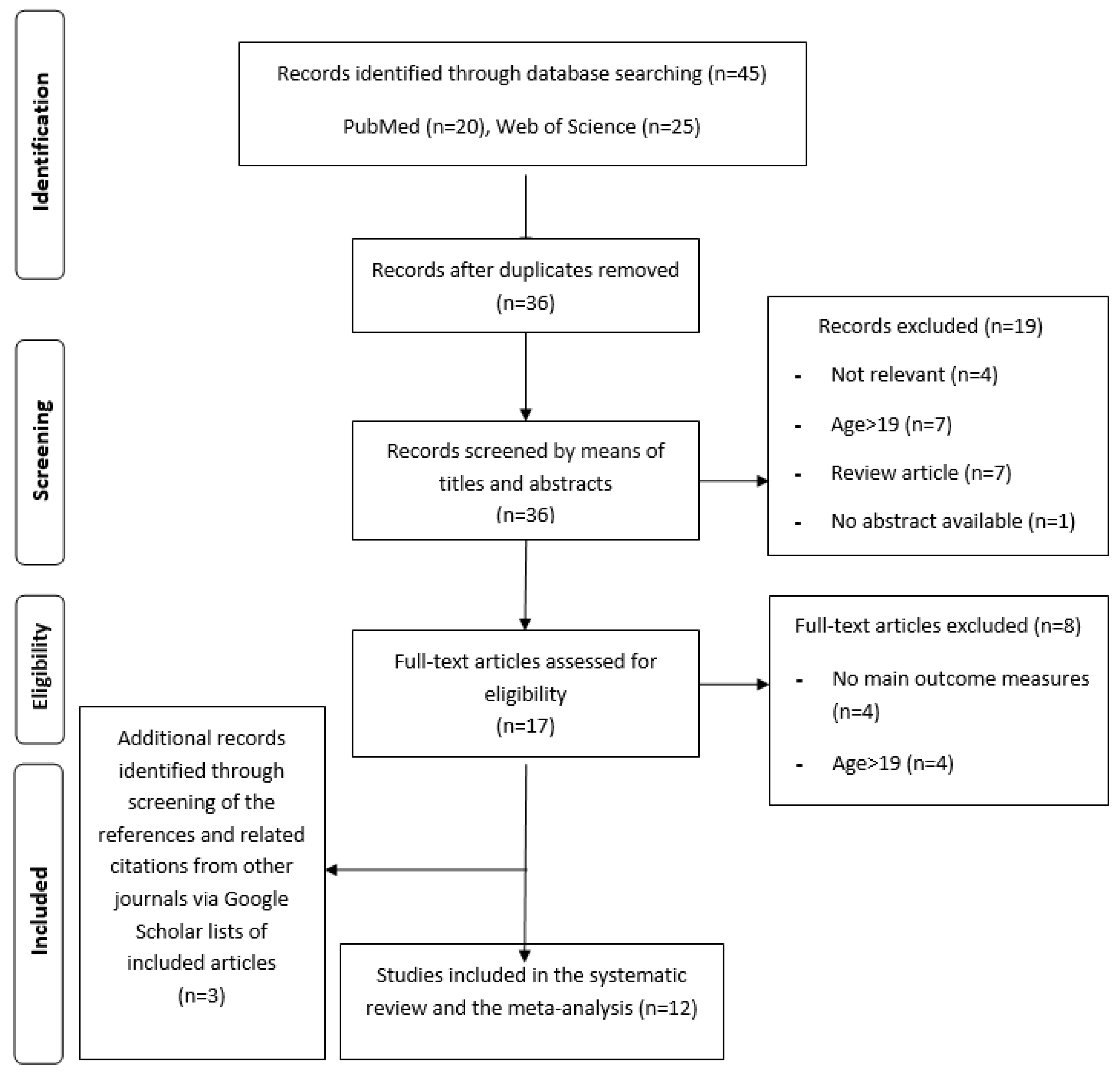
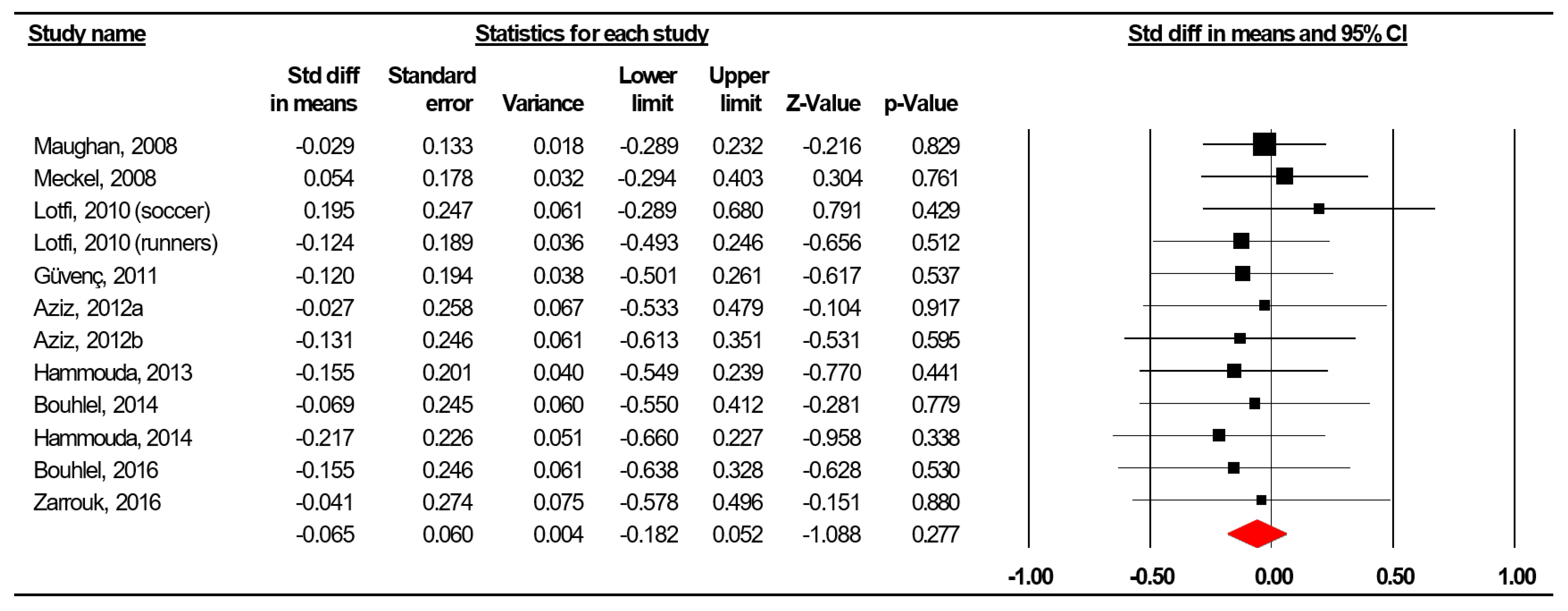
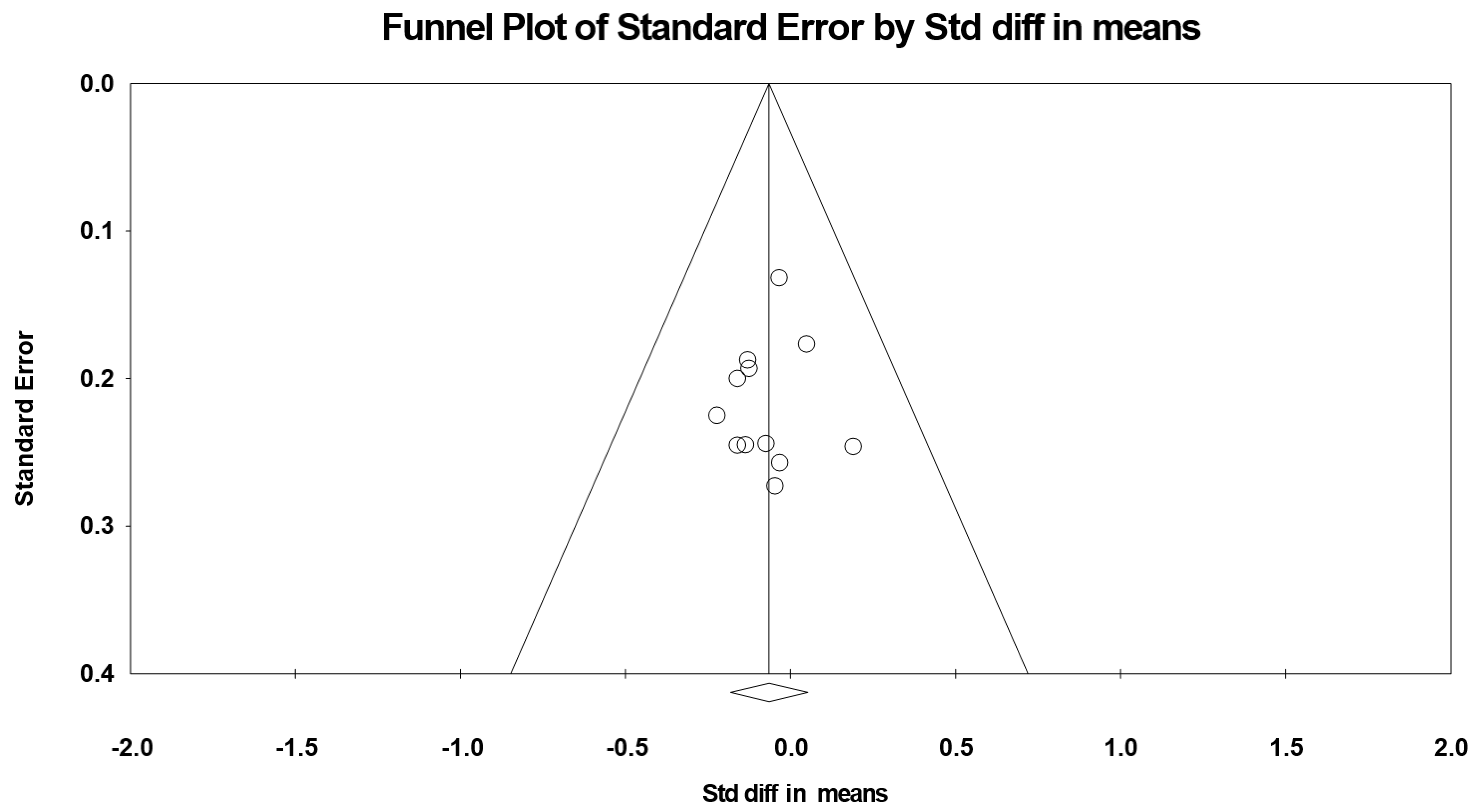
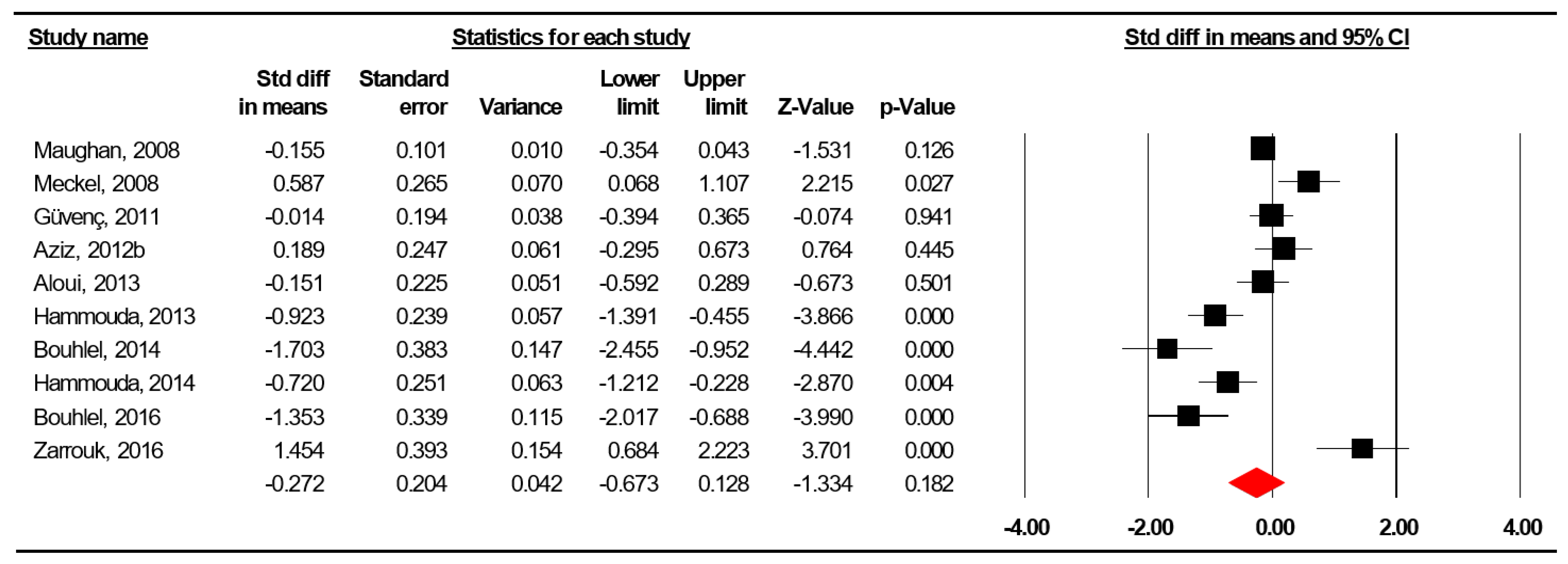
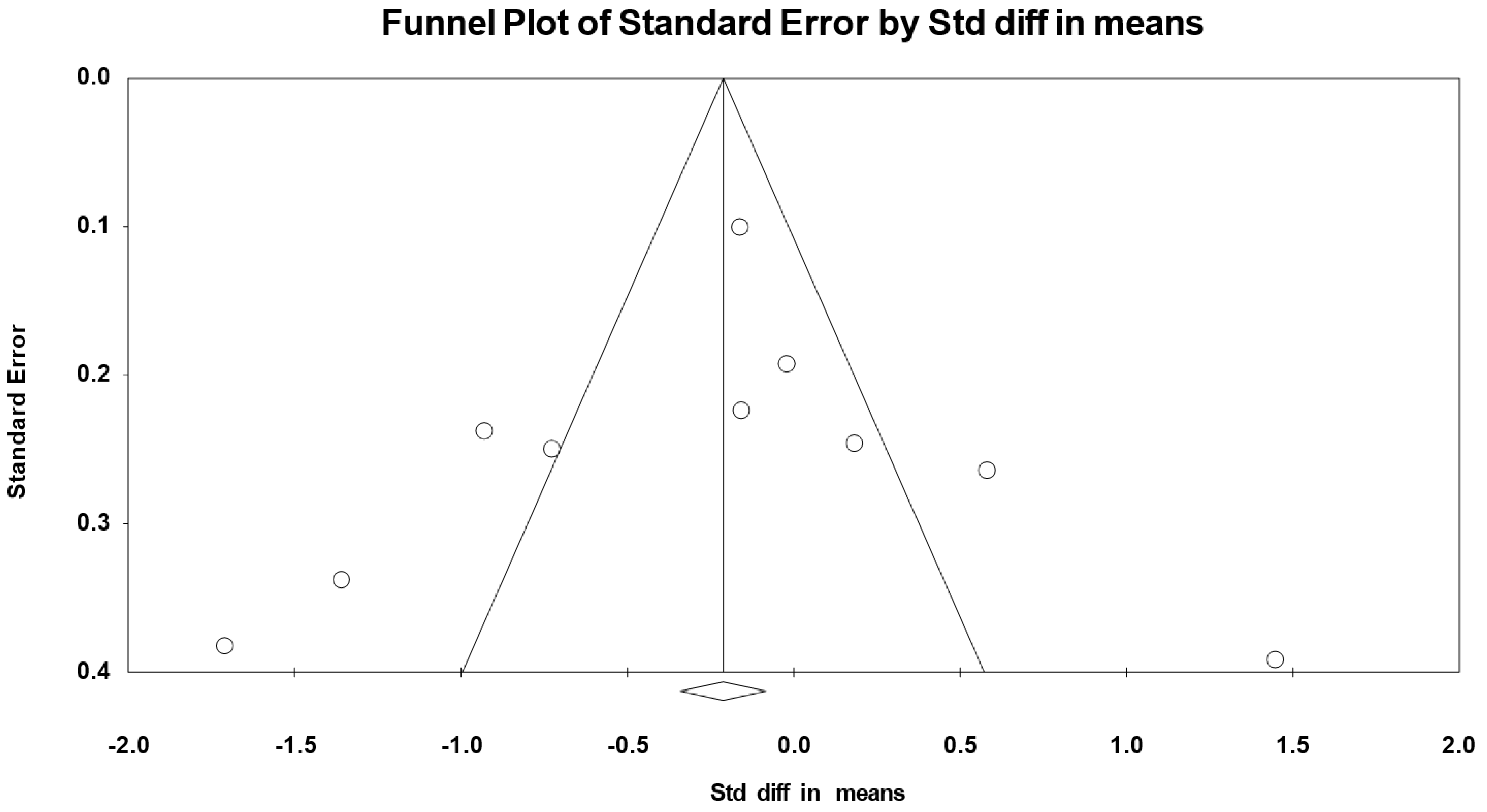
© 2020 by the authors. Licensee MDPI, Basel, Switzerland. This article is an open access article distributed under the terms and conditions of the Creative Commons Attribution (CC BY) license (http://creativecommons.org/licenses/by/4.0/).
Share and Cite
Trabelsi, K.; Ammar, A.; Boukhris, O.; M Glenn, J.; Bott, N.; Stannard, S.R.; Engel, F.A.; Sperlich, B.; Garbarino, S.; Bragazzi, N.L.; et al. Effects of Ramadan Observance on Dietary Intake and Body Composition of Adolescent Athletes: Systematic Review and Meta-Analysis. Nutrients 2020, 12, 1574. https://doi.org/10.3390/nu12061574
Trabelsi K, Ammar A, Boukhris O, M Glenn J, Bott N, Stannard SR, Engel FA, Sperlich B, Garbarino S, Bragazzi NL, et al. Effects of Ramadan Observance on Dietary Intake and Body Composition of Adolescent Athletes: Systematic Review and Meta-Analysis. Nutrients. 2020; 12(6):1574. https://doi.org/10.3390/nu12061574
Chicago/Turabian StyleTrabelsi, Khaled, Achraf Ammar, Omar Boukhris, Jordan M Glenn, Nick Bott, Stephen R. Stannard, Florian A. Engel, Billy Sperlich, Sergio Garbarino, Nicola L. Bragazzi, and et al. 2020. "Effects of Ramadan Observance on Dietary Intake and Body Composition of Adolescent Athletes: Systematic Review and Meta-Analysis" Nutrients 12, no. 6: 1574. https://doi.org/10.3390/nu12061574
APA StyleTrabelsi, K., Ammar, A., Boukhris, O., M Glenn, J., Bott, N., Stannard, S. R., Engel, F. A., Sperlich, B., Garbarino, S., Bragazzi, N. L., Shephard, R. J., & Chtourou, H. (2020). Effects of Ramadan Observance on Dietary Intake and Body Composition of Adolescent Athletes: Systematic Review and Meta-Analysis. Nutrients, 12(6), 1574. https://doi.org/10.3390/nu12061574








